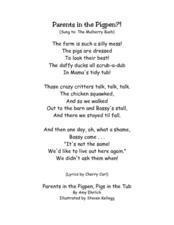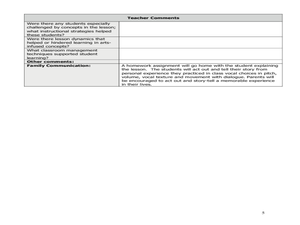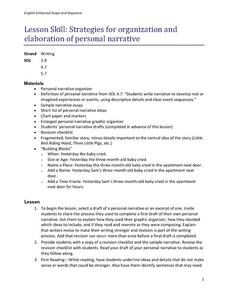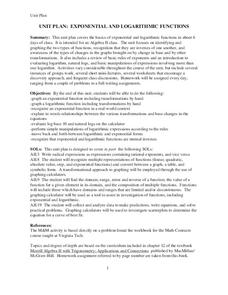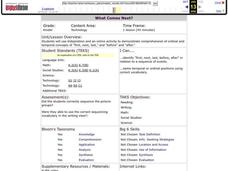Virginia Department of Education
Media Literacy and Persuasive Writing
Investigate ways to persuade by introducing learners to the three rhetorical appeals (Pathos, Logos, Ethos). Pupils receive a worksheet for their definition development of the terms and coinciding vocabulary words. The activity continues...
Curated OER
Inductive and Deductive Reasoning
Students use logical arguments and inductive reasoning to make or disprove conjectures. After observing a teacher led demonstration, students discover that the deductive process narrows facts to a few possible conclusions. In groups,...
Curated OER
Give Into Chance
Young scholars experience choreography that originated from the Postmodern movement. They utilize a chance method by rolling a dice to change the order of a dance sequence. Then they compare this method to traditional methods.
Curated OER
Penguin Writing
After discussing the main events in Mr. Popper’s Penguins, young writers describe in sequence what they would do if they had 12 penguins living in their house. The narratives are then glued onto a penguin cut-out, mounted on construction...
Curated OER
Alphabet Sideshow
Learners practice sound and recognition of letters in alphabetical sequence. They gain an understanding of letter sounds and order. They create a slide show with graphics and text. They present their slide show to the class.
Curated OER
Parents in a Pigpen?!
Like reading, music stimulates multiple parts of the brain. After reading the story, Parents in a Pigpen, Pigs in a Bathtub, learners will practice story retelling by singing this song. These lyrics are intended to accompany the story...
Curated OER
Acting from Inside a Memory
Students work in pairs to out act and then retell a story. For this personal experience lesson, students act out an event in their life and their partner retells the story. Students discuss sequence of events and dialogue. Students...
Curated OER
Count to 200
Only 1, 2, or 3 of 15 boxes are completed in each of 5 vertical number tracks. Your pupils' challenge is to fill in the rest in sequence. Will require counting backwards; modify with number lines.
Curated OER
The Krebs Cycle and Electron Transport
A three-page, mostly multiple choice quiz that would work great as a pretest/post-test for the topic of cellular respiration. It also includes diagram interpretation and a couple of short-answer written response questions. Depending...
Curated OER
Strategies for Organization and Elaboration of Personal Narrative
Personal narrative writing is usually a favorite form of writing for youngsters because they get to write about a personal experience. The lesson here asks pupils to take a piece of narrative writing and improve it by following...
National Research Center for Career and Technical Education
Health Science: Back to Basics
This lesson focuses on unit conversion, proportions, ratios, exponents, and the metric system. Discuss measurement with your math class and demonstrate how to solve several health-science word problems. Give learners a chance to visit an...
Virginia Tech
Unit Plan: Exponential and Logarithmic Functions
A six-day unit for algebra II on exponential and logarithmic functions builds upon Chapter 12 of Merrill Algebra II with Trigonometry; Applications and Connections. The text provides assistance in the depth of instruction...
Novelinks
The Dark Is Rising: Guided Imagery
To launch a reading of The Dark is Rising, the second novel in Susan Cooper's award winning contemporary fantasy novel sequence for young adults, class members engage in a guided imagery exercise that asks them to visualize the...
Curated OER
Future Perfect Tense with Negatives
Do your young grammarians need extra practice using the correct form of verbs in the future perfect tense with negatives? A 10 sentence worksheet will reveal whether or not they have mastered this verb sequence. No answer sheet is included.
Curated OER
Fibonacci Numbers
Students calculate the Fibonacci sequence of numbers. Through the use of Fibonacci numbers in flowers, leaves, fruits, vegetables, pine cones, and other forms of nature; students explore how Fibonacci numbers occur in nature. Then they...
Curated OER
What Comes Next?
Students use Kidspiration and on online activity to demonstrate comprehension of ordinal and temporal concepts of "first, next, last," and "before" and "after." They name temporal or ordinal positions using correct vocabulary.
Curated OER
Social Studies: Personal Chronology
Fourth graders draw ten significant events from their lives on index cards, shuffle them, and trade sets with other students. Their classmates try to place them in chronological order. Next, 4th graders tape their index cards next to...
Curated OER
Patterns
Fifth graders investigate the use of patterns in a data set. The set is disolayed visually using cubes. This helps struggling students to see the quantity in order to make comparisons more effectively.
Curated OER
November - Poetry
First graders respond to poetry through a group activity. They interact with rhythm and tempo in poetry through an oral presentation. They experiment with choral speaking. They discuss Thanksgiving family traditions.
Curated OER
Guided Reading -- If You Give a Mouse a Cookie
Students are read the book "If You Give a Mouse a Cookie" page by page and discuss their favorite types of cookies. They predict what they believe will happen next based on what has already happened in the story. They practice putting...
Curated OER
Scatter Cat!
First graders read the story Hairy MacLary, Scatter Cat by Lynley Dodd, to provide a context in which to use the language of movement and position and to provide opportunities to move themselves as they act out parts of the story.
Curated OER
Eensy Weensy Spider Lesson Plan
Students create their own versions of The Eensy-Weensy Spider. In this creative writing lesson, students read The Eensy-Weensy Spider and imagine what else the spider could do. Students then draw a picture depicting the spider engaged...
Curated OER
A Hodgepodge of Literature
Students complete multiple lessons to study various literature including poetry, fiction, tall tales, and phrases. In this literature lesson, students complete six lessons about poetry, fiction, and idioms.
Curated OER
Connect the Dots - Elephant
In this connect the dots worksheet, students draw lines connecting numbers from one through fifteen to complete a drawing of an elephant. Afterward, they color their creation. This is a one-page worksheet.
Other popular searches
- Signal Words Sequence
- List of Sequence Words
- Time Sequence Words
- Writing Using Sequence Words
- Writing With Sequence Words
- Writing Sequence Words
- Sequence Words in Writing
- Time Sequence Words Only





